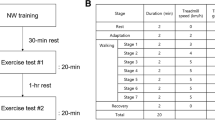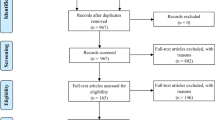Abstract
Purpose
The purpose of this study was to develop and validate a data-supported prediction equation (Lankford equation) for walking metabolic cost (\(C_{\text{W}}\)), and to compare this equation to the ACSM, Pandolf, Minetti, and LCDA equations. The current study also investigated how kinematics of incline walking relates to mechanical efficiency and metabolic cost.
Method
Subjects consisted of 145 recreationally fit individuals. Walking speeds were between 1 AND 3 mph with grades ranging from − 18 to 40%. The Lankford equation was then compared to four other reference equations using adjusted R-squared (R2) and Root Mean Square Error (RMSE) as primary metrics to determine correlation with measured CW. Kinematics data collected from reflective markers placed on bony landmarks were compared to CW, incline, and metabolic efficiency to determine the interrelationship between these variables.
Results
The Lankford equation for estimating \(C_{\text{W}}\) was validated with an adjusted R2 = 0.89 and a RMSE of 5.92 Kj min−1, shown to have the highest accuracy among all equations tested. A 0.21 efficiency plateau was observed above 15% incline, and hip, knee, HAT, thigh, and shank angles at foot touch down were found to be highly correlated with \(C_{\text{W}}\) (r > 0.980).
Conclusion
The Lankford equation is a validated and highly accurate prediction equation for steady-state walking across a wide range of inclines and speeds and is applicable to the general public. Altered leg swing observed above 15% incline was found to account for the mechanical efficiency plateau and the rectilinear increase in \(C_{\text{W}}\) with increasing incline.



Similar content being viewed by others
Availability of data and material
Private sharing link for source data: https://github.com/BYUIDSS/byui_metabolic_equation_lankford.
Abbreviations
- R 2 :
-
Adjusted R-squared
- AIC:
-
Akaike information criterion
- ACSM:
-
American College of Sports Medicine
- BIC:
-
Bayesian information criterion
- BMI:
-
Body mass index
- EE:
-
Energy expenditure
- L :
-
External load carried (kg)
- HAT:
-
Head, arms, and trunk
- HR:
-
Heart rate
- LT:
-
Lactate threshold
- LCDA:
-
Load Carriage Decision Aid
- LogLik:
-
Log-likelihood
- W :
-
Mass (kg)
- \(C_{\text{W}}\) :
-
Metabolic cost of walking
- p :
-
Number of predictors used
- \(\dot{V}{\text{O}}_{2}\) :
-
Rate of oxygen consumption
- RPE:
-
Rate of perceived exertion
- RER:
-
Respiratory Exchange Ratio:
- RMR:
-
Resting metabolic rate
- RMSE:
-
Root mean square error
- n :
-
Sample size
- SS:
-
Self-selected
- S (for the Lankford equation) and V (for all reference equations):
-
Speed
- SSE:
-
Sum of squared errors
- G (percent grade, %) and i (grade in decimal):
-
Surface grade
- η :
-
Terrain coefficient
- SSTO:
-
Total sum of squares
- VT:
-
Ventilatory threshold
References
Abbott BC, Bigland B, Ritchie JM (1952) The physiological cost of negative work. J Physiol 117(3):380–390
American College of Sports Medicine (2014) ACSM guidelines for exercise testing and prescription, 9th edn. Lippincott Williams and Wilkins, Philadelphia, pp 172–173
Astrup A, Gotzsche PC, van de Werken K et al (1999) Meta-analysis of resting metabolic rate in formerly obese subjects. Am J Clin Nutr 69(6):1117–1122
Barstow TJ, Jones AM, Nguyen PH, Casaburi R (2000) Influence of muscle fiber type and fitness on the oxygen uptake/power output slop during incremental exercise in humans. Exp Physiol 85(1):109–116
Bobbert AC (1960) Energy expenditure in level and grade walking. J Appl Physiol 15(b):1015–1021
Borg GA (1982) Psychophysical bases of perceived exertion. Med Sci Sports Exerc 14(5):377–381
Cotes JE, Meade F (1960) The energy expenditure and mechanical energy demand in walking. Ergonomics 3(2):97–119
de Koning JJ, Foster Noordhof DA, Lucia C (2012) Factors affecting gross efficiency in cycling. Int J Sports Med 33(11):880–885
Dionne I, Després JP, Bouchard C, Tremblay A (1999) Gender difference in the effect of body composition on energy metabolism. Int J Obes Relat Metab Disord 23(3):312–319
Epstein Y, Stroschein LA, Pandolf KB (1987) Predicting metabolic cost of running with and without backpack loads. Eur J Appl Physiol Occup Physiol 56(5):495–500
Franz JR, Kram R (2012) The effects of grade and speed on leg muscle activations during walking. Gait Posture 35(1):143–147
Giovanelli N, Ortiz ALR, Henninger K, Kram R (2016) Energetics of vertical kilometer foot races; is steeper cheaper? J Appl Physiol 120(3):370–375
Givoni BRFG (1971) Predicting metabolic energy cost. J Appl Physiol 30(3):429–433
Gotschall JS, Kram R (2006) Mechanical energy fluctuations during hill walking: the effects of slope on inverted pendulum exchange. J Exp Biol 209:4895–4900
Grabowski A, Farley CT, Kram R (2005) Independent metabolic costs of supporting body weight and accelerating body mass during walking. J Appl Physiol 98(2):579–583
Hall C, Figueroa A, Fernhall B, Kanaley JA (2004) Energy expenditure of walking and running: comparison with prediction equations. Med Sci Sports Exerc 36(12):2128–2134
Heglund NC, Cavagna GA (1985) Efficiency of vertebrate locomotory muscles. J Exp Biol 115:283–292
Henneman E (1957) Relation between size of neurons and their susceptibility to discharge. Science 126(3287):1345–1347
Ijmker T, Houdijk H, Lamoth CJ, Beek PJ, van der Woude LH (2013) Energy cost of balance control during walking decreases with external stabilizer stiffness independent of walking speed. J Biomech 46(13):2109–2114
Kappagoda CT, Linden RJ, Newell JP (1979) A comparison of the oxygen consumption/body weight relationship obtained during submaximal exercise on a bicycle ergometer and on a treadmill. Exp Physiol 64(3):205–215
Kenney WL, Humphrey, RH, Bryant CX, Mahler, DA, American College of Sports Medicine (1995) ACSM’s guidelines for exercise testing and prescription 5th edition. 272-283
Klausen B, Toubro S, Astrup A (1997) Age and sex effects on energy expenditure. Am J Clin Nutr 65(4):895–907
Koutlianos N, Dimitros E, Metaxas T, Cansiz M, Deligiannis A, Kouidi E (2013) Indirect estimation of VO2max in athletes by ACSM’s equation: valid or not? Hippokratia 17(2):136–140
Kwan M, Woo J, Kwok T (2004) The standard oxygen consumption value equivalent to one metabolic equivalent (3.5 ml/min/kg) is not appropriate for elderly people. Int J Food Sci Nutr 55(3):179–182
Langford F (1960) Influence of age and body weight on energy expenditure of women during controlled physical activity. ProQuest Dissertations Publishing
Leger L, Mercier D (1984) Gross energy cost of horizontal treadmill and track running. Sports Med 1(4):270–277
Looney DP, Santee WR, Hansen EO, Bonventre PJ, Chalmers CR, Potter AW (2019) Estimating energy expenditure during level, uphill, and downhill walking. Med Sci Sports Exerc 51(9):1954–1960
Ludlow LW, Weyand PG (2017) Walking economy is predictably determined by speed, grade, and gravitational load. J Appl Physiol 123(5):1288–1302
Margaria R, Cerretelli P, Aghemo P, Sassi G (1963) Energy cost of running. J Appl Physiol 18(2):367–370
McMurray RG, Soares J, Caspersen CJ, McCurdy T (2014) Examining variations of resting metabolic rate of adults: a public health perspective. Med Sci Sports Exerc 46(7):1352–1358
Minetti AE, Ardigo LP, Sabiene F (1993) Mechanical Determinants of Gradient Walking Energetics in Man. J Physiol 471:725–735
Minetti Alberto E, Moia Christian Roi, Giulio S, Susta Davide, Ferretti Guido (2002) Energy cost of walking and running at extreme uphill and downhill slopes. J Appl Physiol 93(3):1039–1046
Mooney LM, Rouse EJ, Herr HM (2014) Autonomous exoskeleton reduces metabolic cost of human walking during load carriage. J NeuroEng Rehabil 11(1):80
Naimark A, Wasserman K, McIlroy MB (1964) Continuous measurement of ventilatory exchange ratio during exercise. J Appl Physiol 19(4):644–652
O’Connor SM, Xu HZ, Kuo AD (2012) Energetic cost of walking with increased step variability. Gait Posture 36(1):102–107
Pandolf KB, Givoni B, Goldman RF (1976) Predicting energy expenditure with loads while standing or walking very slowly. J Appl Physiol 43(4):577–581
Santee WR, Blanchard LA, Speckman KL, Gonzalez JA, Wallace RF (2003) Load carriage model development and testing with field data. Technical Note. U.S. Army Research Institute of Environmental Medicine, Natick, MA, ADA#415788
Sawicki GS, Ferris DP (2009) Mechanics and energetics of incline walking with robotic ankle exoskeletons. The Journal of Experimental Biology 212:32–41
Silder A, Besier T, Delp SL (2012) Predicting the metabolic cost of incline walking from muscle activity and walking mechanics. J Biomech 45(10):1842–1849
Van Der Walt WH, Wyndham CH (1973) An equation for prediction of energy expenditure of walking and running. J Appl Physiol 34(3):559–563
Washington R (1999) Cardiorespiratory testing: anaerobic threshold/respiratory threshold. Pediatr Cardiol 20:12–15
Acknowledgment
The authors would like to thank Breanna Neuwirth, Kent Jolley, Emily James, and Michael Dredge for their assistance during data collection and analysis.
Funding
This research did not receive any specific grant from funding agencies in the public, commercial, or not-for-profit sectors.
Author information
Authors and Affiliations
Contributions
DEL was the primary investigator who oversaw the study; YW, JB, JH, and AG carried out data collection, data analysis, manuscript preparation, and manuscript editing. All authors have approved the manuscript.
Corresponding author
Ethics declarations
Conflict of interest
DE. Lankford has performed research consulting for ICON Health & Fitness, manufacturer of the treadmills used in the study.
Ethics approval & Consent to participate
Institutional Review Board at Brigham Young University-Idaho approved the project, and all subjects gave their informed consent prior to the start of the study.
Additional information
Communicated by Jean-René Lacour.
Publisher's Note
Springer Nature remains neutral with regard to jurisdictional claims in published maps and institutional affiliations.
Rights and permissions
About this article
Cite this article
Lankford, D.E., Wu, Y., Bartschi, J.T. et al. Development and validation of a steep incline and decline metabolic cost equation for steady-state walking. Eur J Appl Physiol 120, 2095–2104 (2020). https://doi.org/10.1007/s00421-020-04428-z
Received:
Accepted:
Published:
Issue Date:
DOI: https://doi.org/10.1007/s00421-020-04428-z




